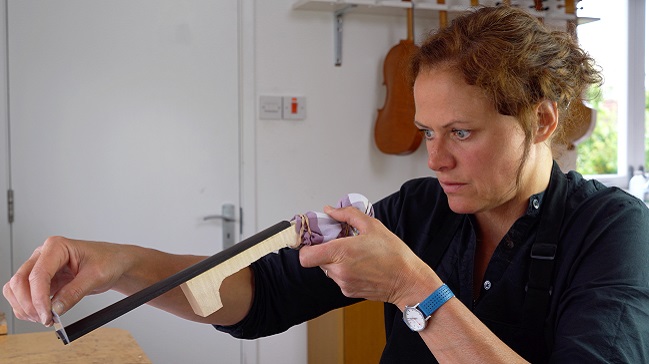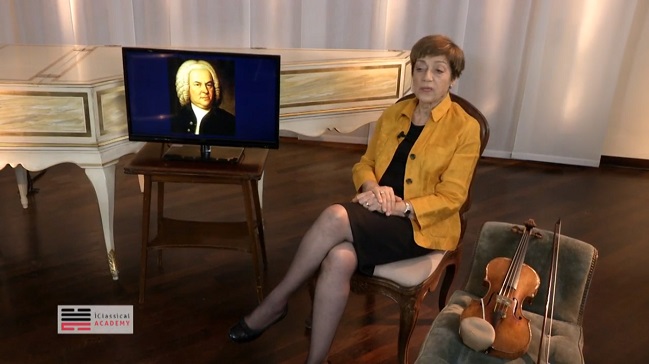A Restorer of Violins, Violas, and Cellos
by Iris Carr

Hello, I am Iris Carr, a restorer of fine violins, violas & cellos for over 25 years.
In 1996 I graduated from the Newark School of Violinmaking with distinction and was offered a position at Charles Beare’s Shop in London. There my training in the restoration of violins, violas, and cellos started, and I was taught by some of the profession's best craftspeople.
In 2004, after 8 years of working for Charles Beare’s Shop, I started up my own business specializing in major restorations of violins, violas, and cellos.
Where I found inspiration
When life took an unexpected turn due to the Coronavirus outbreak, I started to wonder what would happen in the future with the teaching engagements that I have enjoyed so much over the last 8 years.
As violin restorers, we tend to be experts at self-isolating, and I often listen to podcasts whilst I am working. In April 2020, I listened to an American Entrepreneur called Amy Porterfield about creating online courses when the idea started to form in my head of offering an online course about a specific procedure in violin restoration. The idea was that this could be a useful teaching resource for other professional restorers, and decided on a violin neck graft as my first course.
I have been carrying out neck grafts regularly for the last 25 years – a standard but complex procedure that usually requires a timeframe of around 30 hours or so from start to finish. Embracing the opportunity presented by lockdown, I started preparing for the course, questioning every step I take when carrying out a neck graft and consulting with many of my colleagues on how they approach each step and why.

Invisible Neck Graft?
This is what we all aim for when we embark on this complex procedure in violin restoration. But to accomplish a high-end, top-quality neck graft is not an easy and straightforward task, and I regularly come across neck grafts where either the woodwork or the retouching or both have not quite worked out. Competent woodworking and visualization skills are required and the ability to finish well with staining and retouching.
There are so many steps involved in doing a neck graft; it is one of the most complex of all standard procedures in violin restoration and takes around 30 hours from start to finish!
A lot of Concentration
During the last 25 years of doing neck grafts regularly, several neck graft blocks have ended up in my box of off-cuts as I ran out of wood while fitting them. Avoiding visible joint lines is a challenge in itself. Even though it is one of my favorite violin restoration procedures, it is never easy and requires a lot of concentration.
Not everyone has the fortune of having spent time in a top-end restoration workshop and been expertly guided through the process of doing a neck graft. It can be quite daunting to embark on this task, especially if it is not regularly done. That's why I decided to create an online course.
Online Violin Neck Graft Course
In my new online course, I guide you through each step necessary to complete a violin neck graft in chronological order from start to finish. Each step is explained first and then followed by me showing you how I achieve that part of the process. In terms of a timeline, this online course is the equivalent of teaching a 2-week course in person.
This Online Neck Graft Course consists of 2 parts that can be purchased individually. The course includes downloadable PDF files of neck measurements, templates, and a materials and tools list.”
If you're interested in my course, you can find it here.
Looking forward to meeting you in the future!
Iris
About the author
Iris Carr grew up in Philippsburg, a small town near Heidelberg in Germany, and now lives in the UK with her husband and two sons. She graduated from the Newark School of Violinmaking with distinction and was offered a position at Charles Beare’s Shop in London. There Iris’ training in the restoration of violins, violas, and cellos started and she was taught by some of the best craftspeople in the profession.
In 2004, after 8 years of working for Charles Beare’s Shop, Iris started up her own business specializing in major restorations of violins, violas, and cellos. The main bulk of her work comes from violin dealers but also directly from musicians worldwide.
Restorations have included examples from makers such as Stradivari, Amati, Bergonzi, Joseph Guarnerius, S. & G. Seraphin, Gabrielli, Balestrieri, Gagliano, Bellosio, Gobetti, Testore, Rocca, Landolfi, Goffriller, Lupot, Postiglione, Siani, Tecchler, Rogeri and many more. Iris’ international teaching career began in 2012 and she has been teaching general restoration and retouching of instruments in Europe, North America, and Asia. Visit her site
Miriam Fried's Musical Jewel on iClassical Academy
Bach Solo Sonatas and Partitas

The most complete online video encyclopedia about Bach's violin solo repertoire in the world!
Content
- Tutorial 1 - Why the solo Bach Sonatas and Partitas
- Tutorial 2 - Biographical Notes
- Tutorial 3 - In Bach's own words
- Tutorial 4 - History of performance tradition
- Tutorial 5 - The language of music
- Tutorial 6 - Tools - The Bow
- Tutorial 7 - Tools - The left hand
- Tutorial 8 - Identifying the pieces of the puzzle
- Tutorial 9 - Mastering the art of creating illusions
- Tutorial 10 - The Bowings
- Tutorial 11 - Bach Sonatas and Partitas Introduction
- Tutorial 12 - The Sonatas 1st movements
- Tutorial 13 - The Fugues
- Tutorial 14 - The Sonatas 3rd & 4th movements
- Tutorial 15 - The Partitas
Total Running time 3 hours 30 minutes
- High-Quality Video
- Variable speed Stereo High Definition sound
- English Language with toggle for English Subtitles

